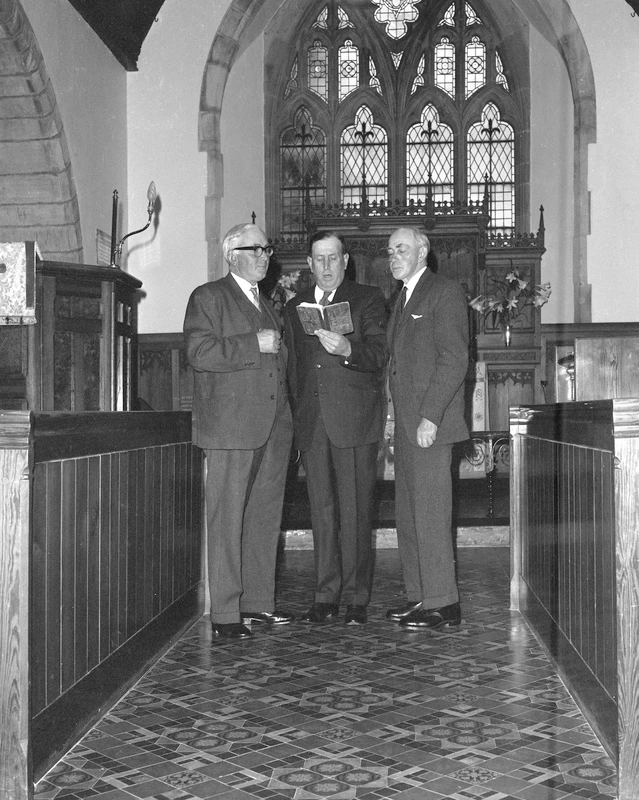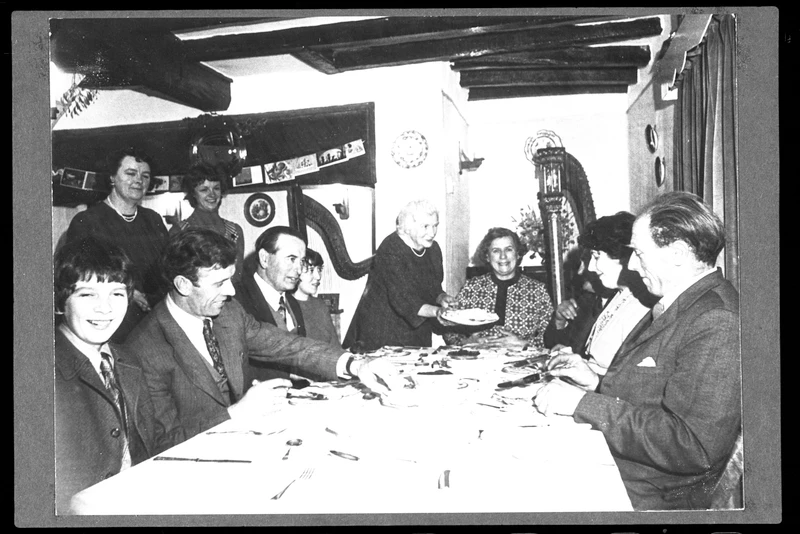Christmas Traditions: 'Plygain' Singing
Christmas Eve
In many parts of Wales, Christmas meant rising early (or staying up overnight) to attend the plygain service at the parish church. The hour for the plygain appears to have varied between 3 a.m. and 6 a.m., the latter becoming more common as time went on. To await the service, young people, in particular, would pass away the time in one way or another.
In some country districts they would gather at certain farmhouses to make cyflaith (treacle toffee) and spend the night merrily, decorating the houses with holly and mistletoe, as at Marford, Flintshire, in the 1830's. According to Mrs. Thrale's journal of a tour in 1774 the inhabitants of Dyffryn Clwyd kindled their lights at two in the morning and sang and danced to the harp until the plygain.
Llanrhaeadr Party singing Plygain carols
In other districts, especially country towns, the time was spent playing in the streets. In Tenby, Pembrokeshire, for example, crowds carried torches, shouted verses and blew cow-horns, before finally forming a torch procession in which the young men of the town escorted the rector from his house to the church. A similar procession is recorded in Laugharne, Carmarthenshire, and also in Llanfyllin, Montgomeryshire, where candles were used instead of torches.
Plygain candles
In the countryside the plygain at the parish church was attended by people from even the remotest farmsteads. Often each person brought his or her candle to help to light the church since, until the nineteenth century, regular services were rarely held at night-time and no provision for lighting was usually made. The brilliant illumination from the candles of the attenders was an important feature of the festival. In Llanfyllin, special candles known as canhwyllau plygain were made by local chandlers in the middle of the 19th century.
During the service the church was decorated inside with chandeliers holding coloured candles and, in Dolgellau, for example, decked with holly. In Maentwrog, Merioneth, candles were also fixed in sockets on the tops of standards or posts fastened to pews here and there in the building. In Lanfyllin the edifice was lighted with some hundreds of candles, placed a few inches; apart from each other, around the walls inside which made the building look very brilliant. In Maentwrog it was the carollers singing in the little gallery at the bell tower end of the church who brought their own candles for it was too dark in that part of the building to follow the service in the Common Prayer Book.
While no doubt the custom varied in detail from parish to parish, the brilliant illumination of the church appears to have made a lasting impression on the memories of those who have left us descriptions, and to have been a striking characteristic of the traditional plygain. As Gwynfryn Richards has suggested, the spiritual significance of candle-lighting at Christmas as a symbol of the coming of the Light of the World, may be discerned in these practices.
The Plygain Service
The plygain itself was an abbreviated form of morning service interspersed with and followed by carols sung by soloists and parties. William Payne described the plygain in Dolgellau as he knew it in the middle of the last century in the following words:
'Now the church is in a blaze, now crammed, body, aisles, gallery, now Shon Robert, the club-footed shoemaker, and his wife, descending from the singing seat to the lower and front part of the gallery, strike up alternately, and without artificial aid of pitch pipe, the long, long carol and old favourite describing the Worship of Kings and of the Wise Men, and the Flight into Egypt, and the terrible wickedness of Herod. The crowds are wholly silent and rapt in admiration. Then the good Rector, and his curate, David Pugh, stand up, and read the Morning Service abbreviated, finishing with the prayer for All Conditions of Men, and the benediction restless and somewhat surging is the congregation during prayers the Rector obliged sometimes to stop short in his office and look direct at some part or persons, but no verbal admonishment. Prayers over, the singers begin again more carols, new singers, old carols in solos, duets, trios, choruses, then silence in the audience, broken at appropriate pauses by the suppressed hum, of delight and approval, till between eight and nine, hunger telling on the singers, the Plygain is over and the Bells strike out a round peal.'
In Maentwrog a sermon was included in the plygain service, but the rector was careful to keep both sermon and service short, as he evidently felt that the chief attraction was not the service but the carolling that followed it. In other places, such as Llanfair Dyffryn Clwyd, holy communion was administered during the plygain.
A Pre-Reformation Survival
Seen against its historical background the plygain is a survival of a pre-Reformation Christmas service modified to suit the new Protestant conditions. Richards points out that plygain in the sixteenth century denoted an ordinary morning service and only at a later date came to be restricted to the service held on Christmas morning. The plygain, he suggests, took the place of the midnight Christmas mass of the Catholic period and was originally associated with a communion service held later on Christmas morning.
The practice of holding the communion service at eight o'clock ended the earlier association between the plygain (morning service) at six, seven or eight o'clock, and the High Mass at nine or ten o'clock. After the Reformation, carol-singing in the vernacular, which had hitherto been excluded from the Latin service of the church at Christmas, was incorporated in the early morning Christmas service, and, as nineteenth-century descriptions plainly show, had become the main attraction of the plygain. John Fisher has drawn attention to the similarity between the Manx festival of Oiel Verrey, held at midnight on Christmas Eve, and the Welsh plygain. He points out that both became popular carol-singing festivals soon after the translation of the Bible into the respective vernacular tongues.
Far from disappearing under the impact of Nonconformity in the nineteenth century, the plygain was one of the few traditional church festivals not discarded by Welsh Nonconformist chapels, although the character of the service was sometimes changed by making it a variation of the ordinary week-night prayer-meeting. As a general custom, the early-morning Christmas plygain ceased towards the end of the last century, although in some cases it survived to a later date.
Plygain Supper at Cefn Llwyn Farmhouse, Llangynyw
The Carol-Singing Tradition in North Wales
In the past, all parts of North Wales shared a strong carol-singing tradition. Nowadays, however, this tradition survives at its most intense in the east midlands, in the predominantly Welsh-speaking areas bounded by Mallwyd, Llanerfyl, Cefnyblodwel (within England) and Llangynog.
For the stranger, attending a plygain service is an unusual experience. For almost two hours, the service is completely in the hands of the carol singers. No programme has been prepared beforehand and no-one acts as announcer, but, each in turn, the carol parties walk forward quietly and leisurely forward to sing. On average there will be eight to fourteen parties present and one is likely to hear between twenty and thirty Christmas carols during the service - all in Welsh and all different, since it is a point of honour not to offer a carol already heard that evening
Adapted from Trefor M. Owen, Welsh Folk Customs (Cardiff, 1959), pp. 28-33


Comments - (7)
I do recall that it started at 4 o clock in the morning, it seemed to last forever and I was frozen stiff.
Dear Mrs Smith,
Thank you for getting in touch with us. I have passed your enquiry to my colleague at St Fagans Museum. She will hopefully be able to advise further on the plygain recording. Just to make you aware, it may take us a little longer than usual to respond over the Christmas break.
Kind regards,
Nia
(Digital team)
Thank you for your help in this
Mrs Heulwen Smith
https://www.youtube.com/watch?v=PLgWRURUnh4
which might be of use with your search.
Nadolig Llawen
Thank you very much for your enquiry. Our archivist at the Welsh Folk Museum has contacted you using the email address you provided.
Kind regards,
Nia
(Digital Team)
Many years ago (1970s) you used to sell recordings of Plygain singing at the Welsh Folk Museum - I think field recordings, probably. In particular, you offered an extended play recording of a family close-harmony singing group called Parti Fronheulog which included Plygain Carols of outstanding quality. I suppose you still have the recordings in your archive.
Do you have any plans to re-issue these recordings or to make them available through your website, or whatever?